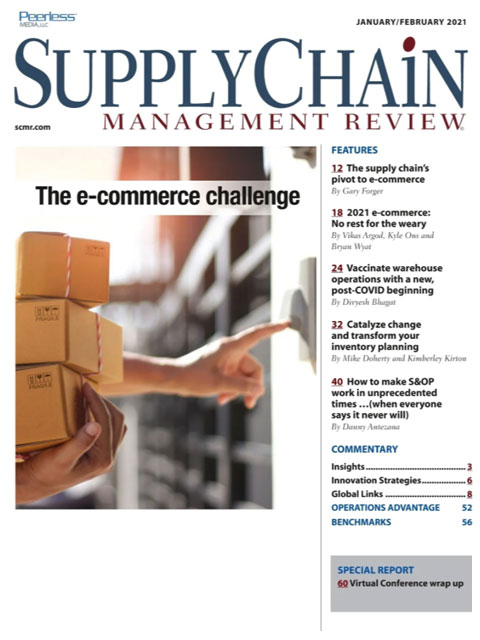Sorry, but your login has failed. Please recheck your login information and resubmit. If your subscription has expired, renew here.
January-February 2021
This morning, I turned on the television and watched the first stretch-wrapped pallets of the just-authorized vaccine being loaded onto a truck at a Pfizer plant in Michigan. From there, the pallets were headed to FedEx’s logistics hub in Memphis where they would be delivered to 153 locations across the 50 states. The event was both historic and mundane: Historic in that the shipments represent the hope of a nation that in the coming months, we’ll begin to put 2020—and COVID—in the rearview mirror; mundane in that this is a scene repeated millions of times a day, without fanfare, in plants and distribution centers across the country. Two of… Browse this issue archive.Need Help? Contact customer service 847-559-7581 More options
All politics is local,” remarked Byron Price, Associated Press’ Washington Bureau Chief, in 1932. He continued, “every politician is looking for the combination which will help him at home.” In the age of omni-channel, with its promise to serve every single consumer with what she wants, when she wants and how she wants, the same is now true for all brands and retailers—all supply chain is local.
It’s no longer sufficient for them to move inventory of mostly standard products to the shelves. Now they have to move tailored product assortments and fulfill orders in myriad ways that respond to local consumer preferences. This creates a dual omni-challenge for supply chains: They will have to handle micro-segmentation efficiently while providing the service consumers demand. Mastering this is what we call shape of demand capability, and it’s entirely possible if supply chain designers understand three things: geo-specific demand, demand drivers and the near- and long-term characteristics of demand.
The “omni-challenge”
No doubt, shopping has changed for good. Consumers now want an omni-channel experience and prioritize speed, simplicity and top-notch service when buying online, in-store and through social media and mobile platforms. Department of Commerce data reflects the shift to a digital experience. The compound annual growth rate for e-commerce sales was 15% from 2015 to 2019. Then it took off with the impact of COVID-19 apparent, reaching 25% year-over-year growth this year. What’s more, we expect e-commerce to reach 20% to 40% penetration levels by 2025, which will also mean a tremendous shift in supply chain dynamics. Buying decisions that used to be made on price and brand attributes are now increasingly being made on product and service.
Therein lie the two challenges for omni-channel supply chains.

This complete article is available to subscribers only.
Log in now for full access or start your PLUS+ subscription for instant access.
SC
MR
Sorry, but your login has failed. Please recheck your login information and resubmit. If your subscription has expired, renew here.
January-February 2021
This morning, I turned on the television and watched the first stretch-wrapped pallets of the just-authorized vaccine being loaded onto a truck at a Pfizer plant in Michigan. From there, the pallets were headed to… Browse this issue archive. Access your online digital edition. Download a PDF file of the January-February 2021 issue.All politics is local,” remarked Byron Price, Associated Press’ Washington Bureau Chief, in 1932. He continued, “every politician is looking for the combination which will help him at home.” In the age of omni-channel, with its promise to serve every single consumer with what she wants, when she wants and how she wants, the same is now true for all brands and retailers—all supply chain is local.
It’s no longer sufficient for them to move inventory of mostly standard products to the shelves. Now they have to move tailored product assortments and fulfill orders in myriad ways that respond to local consumer preferences. This creates a dual omni-challenge for supply chains: They will have to handle micro-segmentation efficiently while providing the service consumers demand. Mastering this is what we call shape of demand capability, and it’s entirely possible if supply chain designers understand three things: geo-specific demand, demand drivers and the near- and long-term characteristics of demand.
The “omni-challenge”
No doubt, shopping has changed for good. Consumers now want an omni-channel experience and prioritize speed, simplicity and top-notch service when buying online, in-store and through social media and mobile platforms. Department of Commerce data reflects the shift to a digital experience. The compound annual growth rate for e-commerce sales was 15% from 2015 to 2019. Then it took off with the impact of COVID-19 apparent, reaching 25% year-over-year growth this year. What’s more, we expect e-commerce to reach 20% to 40% penetration levels by 2025, which will also mean a tremendous shift in supply chain dynamics. Buying decisions that used to be made on price and brand attributes are now increasingly being made on product and service.
Therein lie the two challenges for omni-channel supply chains.
SC
MR


Latest Supply Chain News
- Technology’s role in mending supply chain fragility after recent disruptions
- Tech investments bring revenue increases, survey finds
- Survey reveals strategies for addressing supply chain, logistics labor shortages
- Israel, Ukraine aid package to increase pressure on aerospace and defense supply chains
- How CPG brands can deliver on supplier diversity promises
- More News
Latest Podcast

 Explore
Explore
Procurement & Sourcing News
- Israel, Ukraine aid package to increase pressure on aerospace and defense supply chains
- How CPG brands can deliver on supplier diversity promises
- How S&OP provides the answer to in-demand products
- There is still work to do to achieve supply chain stability
- Blooming success: The vital role of S&OE in nurturing global supply chains
- How one small part held up shipments of thousands of autos
- More Procurement & Sourcing
Latest Procurement & Sourcing Resources

Subscribe

Supply Chain Management Review delivers the best industry content.

Editors’ Picks






